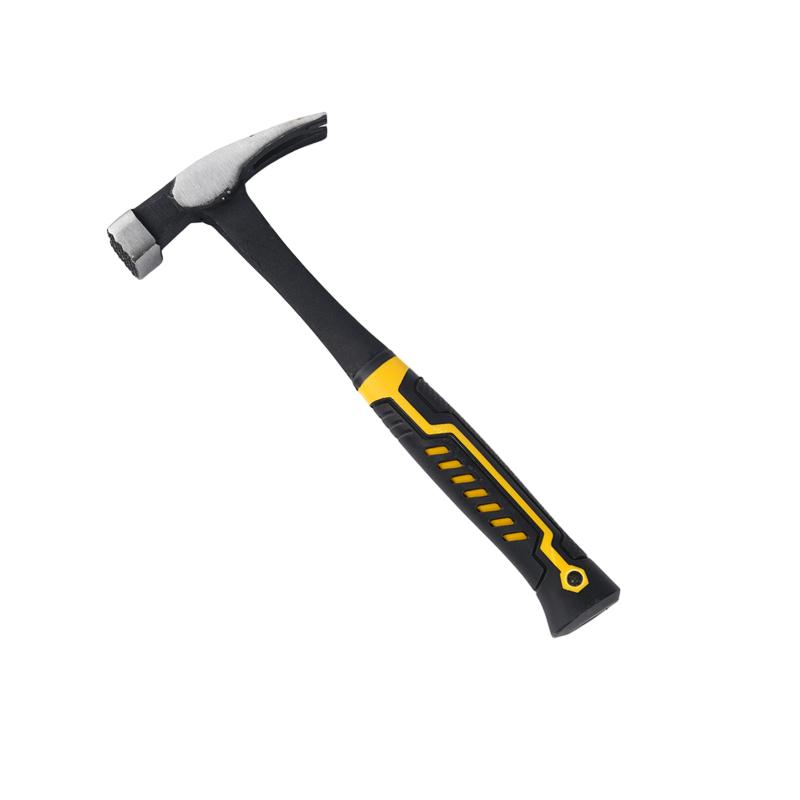This article is a deep dive into the world of hammers, exploring the vast array of types of hammer available and their specific applications. From the ubiquitous claw hammer to the specialized club hammer, we'll uncover the nuances of each tool, helping you understand which hammer is best suited for your needs. Whether you're a seasoned professional or a DIY enthusiast, this guide will equip you with the knowledge to make informed decisions, enhancing both your efficiency and safety. It's worth reading because understanding the right tool for the job is the cornerstone of any successful project.
1. What are the Core Parts of a Hammer?
The hammer, a seemingly simple tool, is actually composed of several key components that contribute to its functionality. Understanding the parts of a hammer is fundamental to appreciating its versatility and choosing the correct one for a specific task.
The primary components include the hammer head, the handle, and the face. The hammer head is typically made of steel, although specialized hammers may utilize other materials. The head's weight and shape are crucial determinants of the hammer's power and intended use. The handle, often crafted from wood, fiberglass, or steel, provides the leverage and grip necessary for effective use. The length of the handle can vary considerably, influencing the force and control exerted during a swing.
The hammer face is the striking surface, which again alters the hammers striking capabilites.
The peen is the oppsite side to the face, and alters in shape depending on application.
2. What Are The Different Types of Hammers and Their Uses?
The world of hammers is surprisingly diverse, with different types of hammers designed for specific tasks. Knowing these various types of hammers and their intended hammers and their uses is critical for both professionals and DIYers.
- Claw Hammer: This is perhaps the most recognizable type of hammer. The claw hammer features a flat face for driving nails and a curved claw for extracting them. It's an essential tool for carpentry and general household repairs. A great example of a claw hammer would be the Multi Purpose Fiberglass Handle Structure High Carbon Steel Customized Claw Hammer.

- Ball Peen Hammer: Primarily used in metalworking, the ball peen hammer has a flat face on one side and a rounded peen on the opposite side. The rounded peen is used for shaping metal and setting rivets.
- Sledgehammer: With its long handle and heavy head, the sledgehammer is designed for heavy demolition work, such as breaking concrete or driving stakes.
- Club Hammer: Also known as a lump hammer, the club hammer has a short handle and a double-faced head. It's used for light demolition, driving chisels, and masonry work.
- Rubber Mallet: This soft hammer features a rubber head, making it ideal for tasks where a metal hammer might cause damage, such as assembling furniture or working with delicate materials.
3. Why is a Club Hammer Called a Club Hammer?
The club hammer, also sometimes referred to as a lump hammer or drilling hammer, derives its name from its appearance. Its short, stout design resembles a club, hence the name.
This type of hammer is typically used for tasks requiring controlled force, such as driving chisels, setting masonry, or light demolition. The compact size and weight distribution of the club hammer allow for precise blows, making it a valuable tool in various trades. Its double-sided head and compact, sturdy build let users make firm contact with other objects.
4. How Does the Curve of a Claw Hammer Affect its Functionality?
The curve of the claw hammer is a defining feature that significantly impacts its functionality. The curved claw is specifically designed for extracting nails.
The curvature provides leverage, allowing the user to rock the hammer and pull the nail out with minimal effort. The degree of the curve can vary between different claw hammer models, affecting the ease and efficiency of nail removal. A more pronounced curve generally provides greater leverage.
5. What are the Most Common Types of Hammer for General Use?
While there are many specialized hammers, certain hammer types are more commonly used for general-purpose tasks. These are the workhorses of the toolbox, versatile enough to handle a variety of everyday jobs.
-
Claw Hammer: As mentioned earlier, the claw hammer is the most versatile and widely used type of hammer, suitable for everything from hanging pictures to building a deck.
-
Ball Peen Hammer: Though primarily a metalworking tool, the ball peen hammer can also be used for general tasks requiring a heavier blow than a claw hammer can provide.
-
Rubber Mallet. The rubber mallet is another versatile tool to have on hand. Because its head is rubber, it's less likely to leave marks on a softer surface.
These common types of hammer represent a solid foundation for any tool collection, capable of addressing a wide range of household and DIY needs.
6. How to Choose the Right Hammer for Your Project?
Choosing the right hammer for a project is crucial for efficiency and safety. Several factors should be considered to ensure you select the most appropriate tool.
First, consider the task at hand. Are you driving nails, shaping metal, breaking concrete, or assembling furniture? The specific application will dictate the type of hammer required. For example, driving nails into hardwood might require a heavier claw hammer or even a framing hammer, while delicate assembly work would be better suited to a rubber mallet.
Second, consider the weight and balance of the hammer. A heavier hammer delivers more force, but it can also be more difficult to control. A lightweight hammer is easier to handle but may require more swings to achieve the same result. The handle length also plays a role, with longer handles providing more leverage but potentially sacrificing accuracy.
Third, consider the materials you'll be working with. A metal hammer can damage delicate surfaces, while a soft-faced hammer may be ineffective on harder materials.
7. What are Some Specialty Hammers and Their Unique Applications?
Beyond the common types, there exists a world of specialty hammers designed for very specific applications. These tools often feature unique designs and materials tailored to their niche uses.
- Brick Hammer: Also known as a masonry hammer, the brick hammer has a flat face for striking and a sharp chisel-like end for scoring and breaking bricks.
- Drywall Hammer: This hammer features a specialized head with a notched blade for scoring drywall and a waffled face to prevent damage to the drywall paper.
- Tack Hammer: A lightweight hammer with a small head, the tack hammer is used for driving tacks and small nails, often in upholstery or craft work.
- Dead Blow Hammer: The dead blow hammer will absorb impacts and reduce the chance of bounce-backs. This is due to the fact the head is usually hollow and filled with sand or lead shot.
- Cross Pein Hammer Is similar to a ball pein hammer, except the pein is straight and perpendicular to the handle, offering precise control.
These specialized hammers demonstrate the incredible adaptability of this seemingly simple tool.
8. What Should You Consider When Choosing a Hammer Handle?
The hammer handle is a critical component that affects comfort, control, and force transmission. There are several factors to weigh when selecting a hammer based on its handle.
- Material: Wooden handles, particularly hickory, are traditional and offer good shock absorption. Fiberglass handles are more durable and resistant to moisture, while steel handles are the strongest but can transmit more vibration. The Hammers hand tool 1000g 1500g 2000g masonry hammer with wooden handle would be a good example.
- Grip: The grip should be comfortable and provide a secure hold, even with sweaty hands. Many hammers feature textured or rubberized grips for enhanced control.
- Length: Handle length affects leverage and control. Longer handles offer more power, while shorter handles provide greater accuracy.
- Shape: Look for a handle that provides a sure, comfortable grip.

9. How Does Hammer Weight Impact Performance?
The weight of a hammer is a crucial factor that directly impacts its performance. Heavier hammers deliver more force with each blow, while lighter hammers offer greater control and speed.
- Heavy Hammers (e.g., Sledgehammers, Club Hammers): These are ideal for demolition work or tasks requiring significant force, such as breaking concrete or driving large stakes.
- Medium-Weight Hammers (e.g., Claw Hammers, Ball Peen Hammers): These offer a balance of power and control, suitable for a wide range of general-purpose tasks.
- Lightweight Hammers (e.g., Tack Hammers): These are best for delicate work or tasks requiring precision, where excessive force could cause damage.
The choice of hammer weight should be tailored to the specific task and the user's strength and experience.
10. What Safety Precautions Should Be Taken When Using a Hammer?
Using a hammer, like any tool, requires adherence to safety precautions to prevent injury.
- Wear Eye Protection: Always wear safety glasses or goggles to protect your eyes from flying debris.
- Inspect the Hammer: Before each use, inspect the hammer for any damage, such as a loose head or a cracked handle. Do not use a damaged hammer.
- Use the Correct Technique: Swing the hammer smoothly and with controlled force. Avoid awkward postures or overreaching.
- Clear the Area: Ensure the area around you is clear of obstructions and other people.
- Use the Right Hammer for the Job: Using the wrong type of hammer can increase the risk of injury. For example, using a claw hammer for demolition work is unsafe and inefficient.
- Check Your Grip: Make sure the handle is dry, and your grip is secure.

Consider where the nail will go after the hit: Ensure that your hammer blows won't send pieces of wood, nails or brick flying.
Summary: Key Takeaways
- The hammer is a versatile tool with many variations, each designed for specific tasks.
- Understanding the different types of hammers and their uses is crucial for choosing the right tool for the job.
- The parts of a hammer, including the head, handle, and face, all contribute to its functionality.
- Safety precautions should always be taken when using a hammer, including wearing eye protection and inspecting the tool before use.
- The weight and handle material of a hammer significantly impact its performance and comfort.
- Specialized hammers exist for niche applications, such as bricklaying, drywall installation, and upholstery work.
- Consider the curve of the hammer when extracting nails.
- Always make sure the striking surface of the hammer, is fit for purpose.
- The carbon Steel TPR Plastic Handle Hammer Stone Hammer Types is a great multi-purpose hammer.
By understanding these key points, you can confidently navigate the world of hammers and select the perfect tool for any project, ensuring both efficiency and safety.
Post time: 03-25-2025





